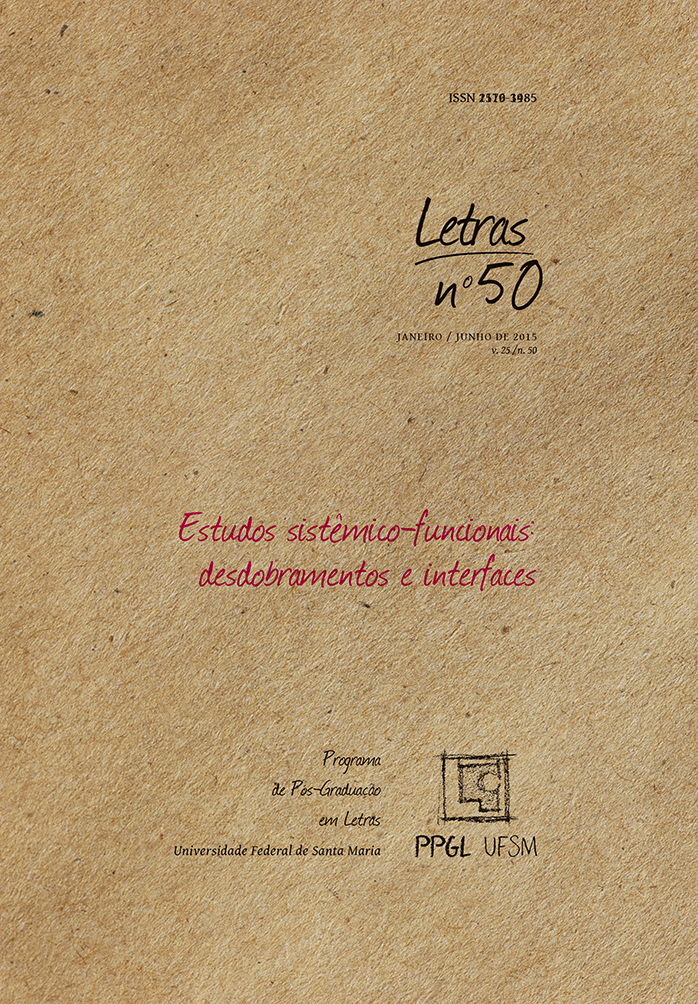The system of conjunction in academic texts: the mechanisms of sequencing and explanation
DOI:
https://doi.org/10.5902/2176148520209Keywords:
Discourse analysis, Conjunction system, Sequencing, Explanation, Academic textsAbstract
Among the six discursive systems proposed by Martin and Rose (2007 [2003]), the system of Conjunction makes it possible to analyze the relationships within the processes of a text based on the four general types of conjunction: addition, comparison, time and consequence. Using samples from texts in the Systemics Across Languages – SAL corpus, our objective in this study is to observe how the conjunctive relationships are characterized in academic texts, focusing on the lexico-grammatical instances of sequencing and explanation, as a way of exploring academic texts in four distinct modes: undergraduate article, concluding undergraduate work, Master’s thesis, and Doctoral dissertation. The main objective is to explore how the mechanisms are organized at the four academic levels, and what these mechanisms reveal about text production, providing support for other studies on academic genres and texts, which can then be used at the basis for academic literacy proposals, primarily aimed at researchers in training and their text production, as well as teaching writingDownloads
References
CASTILHO, A. T. Nova gramática do português brasileiro. São Paulo: Editora Contexto, 2010.
HALLIDAY, M. A. K. Language as social semiotic: the social interpretation of language and meaning. London: Edward Arnold, 1978.
HALLIDAY, M. A. K. An introduction to functional grammar. London: Edward Arnold, 1985.
HALLIDAY, M. A. K. An introduction to functional grammar. 2nd edition. Londres: Edward Arnold, 1994.
HALLIDAY, M. A. K. Text semantics and clause grammar: how is a text like a clause? In: WEBSTER, J.J. (Ed.). On grammar – Volume 1 in the Collected words of M.A.K. Halliday. Londres e Nova York: Continuum, 2002, pp. 219-260.
HALLIDAY, M. A. K.; HASAN, R. Cohesion in English. London and New York: Longman, 1976.
HALLIDAY, M. A. K; MATTHIESSEN, C. M. I. M. An introduction to functional grammar. Third Edition. London: Hodder Education, 2004.
MARTIN, J. R. English text – System and structure. Philadelphia/Amsterdam: John Benjamins Publishing Company, 1992.
MARTIN, J. R. Discourse studies. In: HALLIDAY, M. A. K; WEBSTER, J. J. Continuum companion to Systemic Functional Linguistics, 2009, pp. 154-165.
MARTIN, J. R.; ROSE, D. Working with discourse – Meaning beyond the clause. London and New York: Continuum, 2007 [2003].
MENDES, W. V. As circunstâncias e a construção de sentidos no blog. Dissertação de mestrado em Letras. Pau dos Ferros: Universidade
Estadual do Rio Grande do Norte, 2010.
NEVES, M. H. M. Gramática de usos do português. 2a ed. São Paulo: Editora da Unesp, 2011.
SCOTT, M. WordSmith Tools. Oxford: Oxford Univesity Press, 2012.







